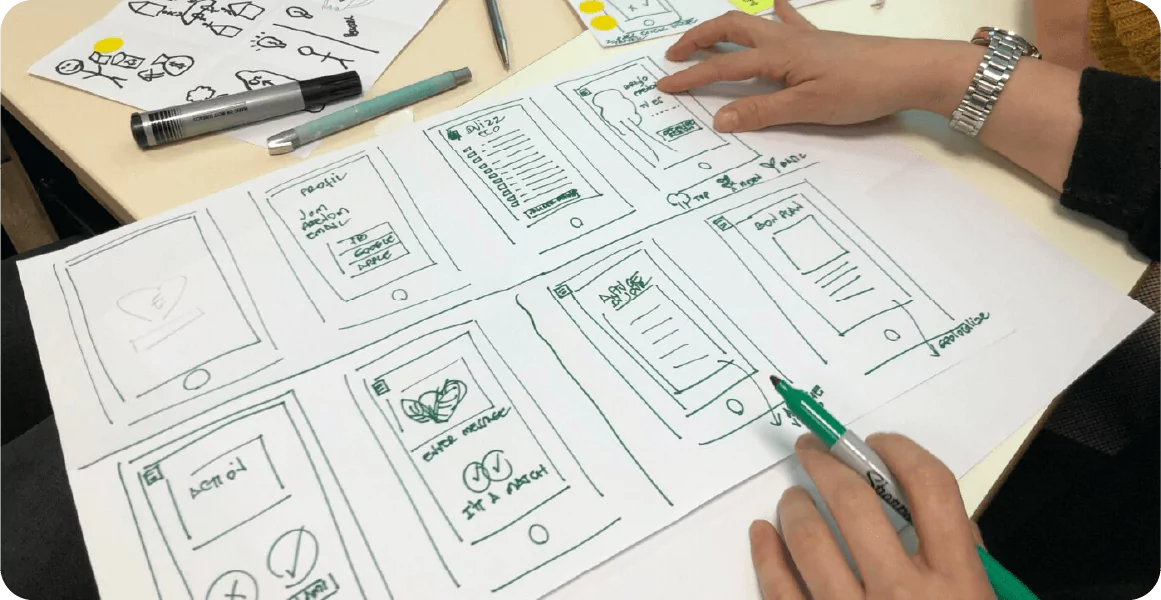Hey there, welcome to the world of ecommerce! You know, where a killer website can turn curious clicks into loyal customers. In today's digital age, having a website that really packs a punch is key for businesses aiming to stand out online. It's not just about showing off your stuff – it's about giving folks an experience they won't forget, one that makes them want to hit that buy button.
But what's the secret sauce behind a knockout ecommerce website? And why should you care about investing in top-notch design?
Well, in this post, we're diving deep into the world of ecommerce website design. We'll chat about why it's so darn important and peek behind the curtain to see how designers work their magic. Get ready to uncover the secrets to creating websites that'll have folks hitting "add to cart" faster than you can say "online shopping spree!"
Think about it: when someone lands on your site, that's their first impression of your brand. So yeah, it's gotta be good. A slick, professionally designed website builds trust and makes folks feel confident about buying from you.

But it's not all about appearances – it's about how the darn thing works too. A great ecommerce website is easy to navigate, with clear product descriptions and killer visuals that help folks make up their minds about what to buy.
Oh, and let's not forget about SEO – that's search engine optimization for the uninitiated. By sprinkling some SEO magic into your website design, you can boost your chances of showing up higher in search results and bringing in more folks who are ready to buy.
And hey, with more and more folks shopping on their phones these days, having a mobile-friendly site is non-negotiable. You gotta make sure your site looks good and works like a charm no matter what device folks are using.
So yeah, ecommerce website design is pretty darn important. It's all about creating a killer site that not only looks good but also drives sales and turns casual visitors into die-hard fans of your brand.
When I think about ecommerce website design, one thing stands out: understanding my audience is key. I mean, what good is a stunning website if it doesn't click with the folks who actually use it?

So, to really get inside the heads of my audience, I gotta dig deep. I'm talking about more than just knowing their age or where they live – I need to understand what makes them tick. That means diving into their preferences, habits, and what keeps them up at night. Market research and chatting with customers are gonna be my best friends here.
Once I've got a handle on what my audience wants, I can tailor every inch of my website to fit their vibe. From the layout and colors to the words I use, it's all about speaking their language and making them feel right at home.
But, I know I'm not perfect – that's why user testing is gonna be a big part of my game plan. By watching how folks use my site and listening to their feedback, I can spot any hiccups and smooth them out in no time.
At the end of the day, it's not just about making things look pretty – it's about creating an experience that my audience loves. When I really get where they're coming from, I can build a website that speaks directly to them, and that's when the magic happens.
When it comes to my ecommerce website, I know that nailing the user experience (UX) is a game-changer. It's all about making sure my customers have a smooth ride from start to finish – because happy customers mean more sales for me!

First off, easy navigation is key. I want folks to find what they're after without breaking a sweat. That means clear menus, a handy search bar, and categories that make sense.
And let's not forget about mobile users – they're a big deal these days. So, I'm making sure my site looks just as good on a phone as it does on a computer. Responsive design is where it's at!
Of course, I want my site to look good too. High-quality images, videos, and a consistent brand vibe? Yeah, that's gonna make my products look irresistible.
When it comes to making a purchase, I'm keeping things simple. Nobody likes a complicated checkout process, so I'm streamlining things to make it as painless as possible. That means fewer steps, less hassle, and more completed transactions.
Bottom line? Putting user experience front and center on my ecommerce site is a no-brainer. It's all about making life easier for my customers, keeping them engaged, and ultimately, raking in those sales.
When it comes to my ecommerce website design, I know visuals are everything. People are all about the eye candy these days, so I'm making sure my site is a feast for the eyes!

First off, I'm all about those high-quality product images. I want my customers to see every little detail, so I'm showing off my items from every angle. Crisp, clear, and zoomable – that's the name of the game.
And let's talk about branding. I'm keeping things consistent across the board – from my logo to my colors and fonts. It's all about creating a vibe that screams "me" and makes my brand stand out from the crowd.
But visuals aren't just about pretty pictures. I'm also throwing in some interactive stuff, like videos and animations. Whether it's showing off my products in action or sharing some happy customer testimonials, I'm all about keeping folks engaged.
And typography? That's a biggie too. Clear headings and snappy product descriptions are making it a breeze for my customers to find what they're looking for.
But, I'm not going overboard with the visuals. I know there's a fine line between eye-catching and overwhelming, so I'm keeping things clean and clutter-free.
By putting visuals front and center in my ecommerce website design – with killer product images, consistent branding, interactive content, and easy-to-read typography – I'm giving my customers an experience they won't forget.
I know that the checkout process can make or break a sale. So, I'm making sure it's as smooth and user-friendly as possible!

First off, simplicity is key. I'm keeping things super straightforward, with as few steps and fields as possible. I want my customers to breeze through the checkout without any hassle.
And of course, security is a top priority. I'm making sure to implement secure payment gateways and SSL certificates to keep my customers' data safe. Trust badges are also a must to give them peace of mind.
I'm also offering multiple payment options to cater to everyone's preferences. Whether they prefer credit cards, PayPal, or digital wallets, I want my customers to have the flexibility to choose what works best for them.
Oh, and those progress indicators? They're a game-changer. I'm making sure my customers know exactly where they are in the checkout process so they can see the finish line.
And for those who aren't ready to commit to creating an account, I'm offering a guest checkout option. I want to make it as easy as possible for first-time customers to complete their purchase without any extra hassle.
At the end of the day, a smooth checkout experience is key to turning clicks into sales. By focusing on simplicity, security, payment options, progress indicators, and guest checkouts, I'm making sure my customers have the best possible shopping experience from start to finish.
In today's fast-paced digital world, I know that mobile optimization is absolutely critical for the success of my ecommerce website. With more and more people using their smartphones and tablets to browse the internet, I need to make sure that my site is fully optimized for mobile devices.

One thing I'm focusing on is responsive web design. This means that my website will automatically adjust its layout and content to fit whatever screen size someone is using. By doing this, I can give my visitors a seamless experience no matter what device they're on.
Another big priority for me is page load speed. I know that mobile users don't have a lot of patience, so I'm working hard to optimize my site's loading times. Faster load times mean happier customers and lower bounce rates.
I'm also paying close attention to how I'm using images and videos on my site. Large files can really slow things down, so I'm making sure to compress my images and use efficient video formats to keep everything running smoothly on mobile devices.
And when it comes to navigation, I'm keeping things simple. I know that smaller screens can make it tricky to navigate, so I'm using drop-down menus and collapsible options to make it easy for my visitors to find what they're looking for.
I'm also making sure that all of my buttons and calls-to-action are easy to use on touchscreens. By making it effortless for people to add items to their carts and complete purchases, I'm hoping to see higher conversion rates across all devices.
Overall, I'm making mobile optimization a top priority for my ecommerce website. By focusing on responsiveness, page speed, image and video optimization, navigation usability, and touch-friendly features, I'm confident that I can provide an exceptional experience for all of my visitors, no matter how they're accessing my site.
I understand the importance of tracking and analyzing data to keep driving success. By getting a clear picture of how my target audience behaves, I can make smart decisions to optimize my site and boost conversions.

One of the ways I track data is by using web analytics tools like Google Analytics. They give me valuable insights into who visits my site, where they come from, and how they interact with it. By digging into this data, I can spot trends and patterns that help me fine-tune my marketing strategies.
Monitoring key performance indicators (KPIs) is also crucial. I set specific goals for metrics like conversion rate, average order value, and customer lifetime value. Regularly keeping an eye on these KPIs lets me see how effective my ecommerce website design efforts are.
I also use heat mapping tools to get a visual representation of user interaction on my site. This helps me pinpoint any areas where visitors might be struggling or encountering roadblocks on their path to making a purchase.
By staying on top of the data collected from these different sources, I can make informed decisions to enhance user experience and drive more sales on my website. Data analysis isn't a one-time thing; it's an ongoing process that requires constant attention to stay ahead of changing consumer behaviors.
In the end, tracking and analyzing data are essential parts of ensuring the success of my ecommerce website design. They give me valuable insights into user behavior, highlight areas for improvement, and empower me to make informed decisions based on real-time information.
For any online business striving for success, leveraging the expertise of ecommerce website designers is paramount. These skilled professionals possess a rare combination of creativity, technical know-how, and strategic acumen that can truly elevate your digital presence.

Consider tapping into the talents of ecommerce website designers to create visually captivating and user-friendly websites. With their keen understanding of your target audience's needs and preferences, they can craft an online shopping experience that is not only visually appealing but also seamless and enjoyable.
Furthermore, ecommerce website designers excel in optimizing user experience (UX) design, ensuring that every step of the customer journey is smooth and friction-free. By simplifying processes and enhancing navigation, they can significantly boost customer satisfaction and drive conversion rates.
Branding is another area where ecommerce website designers shine. They have a knack for incorporating branding elements throughout the website, from logos to color schemes, to create a cohesive brand identity. This not only fosters trust but also enhances brand recognition among potential customers.
Additionally, ecommerce web developers play a pivotal role in creating a hassle-free checkout process. By identifying and addressing potential obstacles that may lead to cart abandonment, they can streamline the checkout experience and increase conversions.
Mobile optimization is also key in today's digital landscape, and ecommerce website designers understand its importance. With more consumers shopping on mobile devices, responsive design ensures that your website is accessible and user-friendly across all devices, leading to increased traffic and sales.
Lastly, it's essential to recognize that the work of ecommerce website designers doesn't end once the website is launched. They continuously track trends, monitor user behavior, and analyze data to make necessary improvements and keep your website ahead of the curve.
In conclusion, leveraging the expertise of ecommerce website designers is not just beneficial but essential for the growth and success of your online business.
When hiring an ecommerce website designer, there are several important factors I consider to ensure I make the right choice:

In conclusion, I understand that the success of my online business hinges on choosing the right ecommerce website designer. Therefore, I take the time to research, ask for references, and make informed decisions.
In today's digital age, a well-designed ecommerce website is crucial for the success of any online business. Ecommerce website designers play a vital role in creating websites that not only attract visitors but also convert them into loyal customers.
By understanding the target audience and incorporating user experience (UX) design principles, ecommerce website designers can create intuitive and engaging websites that meet the needs and preferences of users. Visuals and branding are also important elements in establishing a strong online presence and building trust with customers.
A seamless checkout process is essential to ensure a smooth transaction for customers, reducing cart abandonment rates. Mobile optimization cannot be overlooked either, as more and more people are using their smartphones to shop online.
Tracking and analyzing data is another critical aspect of successful e-commerce websites. By monitoring visitor behavior, conversion rates, and other metrics, businesses can make informed decisions to improve their online performance continuously.
Ecommerce website designers play an indispensable role throughout this entire process. Their expertise in web development services allows them to bring all these elements together seamlessly, making the magic happen behind the scenes.
When hiring an ecommerce website designer, it’s essential to consider factors such as their portfolio of previous work, industry experience, knowledge of current trends and technologies, as well as client testimonials or reviews. Finding someone who understands your business goals and can deliver results is key to achieving success in the competitive world of e-commerce.
So if you want your business to thrive in today's digital landscape, investing in professional ecommerce website design services is non-negotiable. With their expertise at hand – combined with your unique products or services – you'll have all the tools necessary to turn clicks into satisfied customers!
Remember: Great design equals great conversions! Find an experienced ecommerce website designer today and watch your online store flourish like never before!